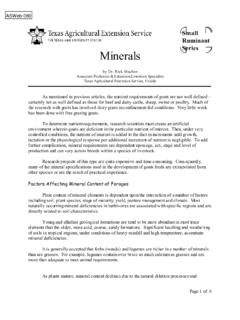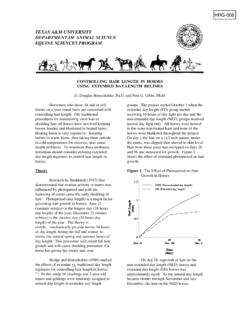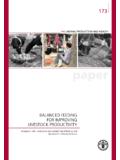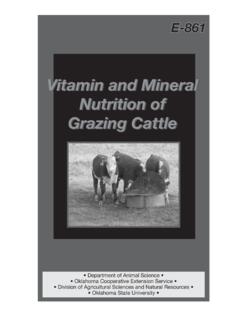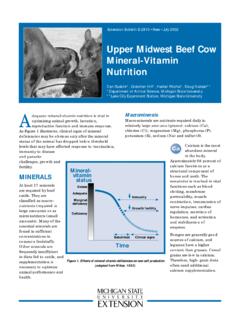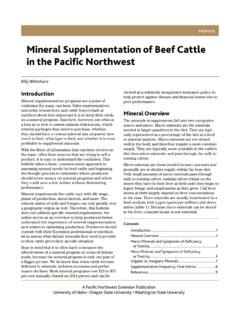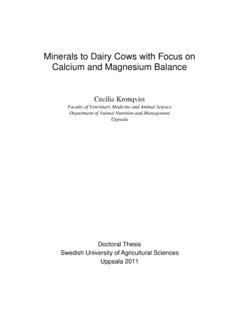Transcription of Mineral Supplementation of Beef Cows in Texas
1 Mineral Supplementation ofBeef cows in TexasDennis B. Herd*The proper balance of protein,energy, vitamins and all nutri-tionally important minerals isneeded to make a successfulnutrition program, one that sproductive yet balance is the key toany effective nutrition pro-gram, especially where traceminerals are concerned. Today,there is concern that the traceelements may be limiting pro-duction in better managedherds to a much greater extentthan generally starvation or hollowbelly is still the primary limit-ing factor in many less wellmanaged herds. Supplementa-tion programs cannot economi-cally overcome the negativeeffects of overgrazing. Be sureyou have your nutritional man-agement priorities in the prop-er order. It won t make youmoney to furnish cattle 150percent of their Mineral needsif they re only receiving 85 per-cent of their protein and energyneeds or vice , But Still RelevantPhosphorus ResearchThe importance of phosphorussupplementation in Texas hasbeen realized ever sinceresearch studies in the 1930sand 40s at the King Ranch.
2 InTrials 1 and 2, percent calf cropweaned increased 40 and 41percent, weaning weightincreased 69 and 49 pounds,and calf weight weaned percow exposed increased 156 and165 pounds, respectively, withphosphorous Supplementation (Appendix Table 1). Return perdollar invested in phosphorus,at today s prices, ranged from$ to $ depending onthe method and amount ofsupplementation (AppendixTable 2). As a result of thesestudies, it became a goal ofmany cattlemen to pounds of actual phospho-rus per cow per year. Sixpounds of supplemental phos-phorus intake/cow/year is stilla reasonable goal for cowsgrazing on native, unfertilizedpastures with little or no pro-tein or energy supplementa-tion. Educators and cattlemenmistakenly assumed that cowsgrazing improved fertilizedpastures also needed as muchas 6 pounds of phosphorus/cow/year.
3 More is now knownabout the effect of forage typeon Mineral content and appro-priate Field ExperienceSince 1986, direct field experi-ence has occurred with morethan 50 ranchers (most but notall in Texas ) who were experi-encing trace Mineral nutritionproblems in their herds. Pro-duction losses ranged fromslight to severe. In one herd thecalf crop fell to 55 percent afterhaving run from 85 to 95 per-cent for years. In another herd,10 out of the first 20 calvesdied soon after birth. Innumerous herds, cattle oftenappeared wormy, but did notrespond to deworming. Theworst problems were alwaysfound in purebred continentalbreeds of cattle. Most problemsinvolved the trace Mineral cop-per and sometimes zinc andselenium. Mineral imbalances,rather than simple mineralPlease see Table 4, page 7,for detailed informationon Recommendations onMineral Supplements.
4 *Professor and Extension beef CattleNutritionist, The Texas A&M UniversitySystem EE-526deficiencies, were frequentlyfound. Sulfur (>.3 percent) andiron (>250 PPM) levels wereoften high in diets which areantagonistic to copper and sele-nium utilization. Molybdenum,a well-known copper antago-nist, was not extremely high,but would reach 2 to 3 PPMwhich is a problem when com-bined with high sulfur. Thispublication deals with a sys-tematic approach to mineralsupplementation based onexperiences with these problemherds and data from researchliterature. Performance in theseproblem herds returned toacceptable levels with mineralsupplementation practicesdescribed in this publication. Need for MineralsMaintenance, growth, lactation,reproduction and animal healthcannot be optimized wheremineral intake is not properlybalanced.
5 Afull discussion ofthe functions and deficiencysymptoms of all required min-erals is beyond the scope ofthis paper. Libraries are filledwith books on the subject. Thisdiscussion will center aroundmineral Supplementation Emphasison Trace MineralsTrace Mineral supplementationneeds are greater today thanever before because:1. More is known about theiressential functions and pro-duction losses, resultingfrom marginal deficiencieswhich often existed in thepast but were not recog-nized. In some casesrequirements are simplymore accurately Genetic potential for perfor-mance and productivity ofcattle has probably increasedrequirements. Today cattleare pushed to perform muchnearer their genetic poten-tial. Generally, a good jobwith protein and energy sup-plementation is practiced,but trace Mineral nutritionhasn t kept In cattle, sheep and humans,genetics can greatly influ-ence copper requirementsand susceptibility to toxici-ty.
6 For years it has beenwell-established that breedsof sheep vary in their sus-ceptibility to copper toxicityand requirements for research indicatesSimmental and Charolaiscattle require more copper intheir diet than Angus. Fieldexperiences suggest thatSimmental, Maine Anjou,Limousine and Charolaiscattle all benefit from the copper intake nor-mally defined for traditionalbreeds. On the other hand, itappears that Jersey cattle are much more susceptible tocopper toxicity (possibly aslow as 40 PPM of the dietcompared to the normallyaccepted 100 PPM) thanHolsteins. Brahman cattlemay be more susceptible tocopper toxicity than otherbeef breeds. Thus, you mustcarefully evaluate the needsof your particular breed ofcattle. Genetic differencesquite likely exist within Wherever yields of cropshave been increased withnitrogen, phosphorus andpotash fertilizers withoutaccompanied repletion oftrace elements, the content ofmany of the trace elementsin feedstuffs has decreasedover time.
7 The decrease isespecially true for shallowrooted Liming, fertilization practicesand/or industrial pollutionmay be altering the composi-tion or proportion of miner-als in forages in 1. Various breeds have advantages and disadvantages in also has an influence on the amount of copper needed for reproductionand good It has become evident inrecent years that trace miner-al deficiencies are the rootcause or contributing factorfor health problems and fail-ures of commonly accepteddisease treatments. Researchwith rats and mice over thelast 10 to 15 years has estab-lished many of the biologicalmechanisms by which thebody fights other mineralsmay be involved, muchwork with copper, zinc andselenium has shown them tobe essential to the immunesystem and the body s dis-ease defense mechanisms(2)(3)(4)(5). On a more prac-tical basis, research studiesand numerous field casesreported by practicing vet-erinarians have related defi-ciencies of specific trace min-erals to the frequency andseverity of such problems asmastitis, retained placenta,stillbirths, embryo mortali-ty, general reproductivefailure, weak calves anddummy calves at birth with-out good nursing reflexes,calf scours, abomasal ulcersin calves, pneumonia, andapparent vaccine There is good evidence that ahigher level (possibly 25 to50 percent) of some traceminerals may be needed forgood health than for normalgrowth.
8 The appropriate lev-els remain to be defined, butthere is work ongoing in Approach ToMineral Supplementation : Balance Their Rations Successful commercial poultry,swine, dairy and feedlot opera-tions all balance the rations fortheir livestock ! Don t you thinkit s time ranchers do too?Admittedly, a rancher can t bal-ance the diet of a range cow aseasily or as accurately as themanager of a confinementoperation. However, the onlyway to solve Mineral problemswhere excesses and deficienciesoccur simultaneously is tomake an effort to balance Mineral -related perfor-mance problems in the herdsmentioned earlier were solvedby obtaining the necessaryinformation and balancing thecattle s NeededTo balance rations, you musthave the following informa- nutrient requirements ofthe particular class of cattle:Include insurance levelsdesired to account for factorssuch as breed, genetic poten-tial and inherent variation infeed nutrient content of thefeeds they eat:a)Book values are reason-ably accurate for concen-trate feeds and values areconstantly being updatedwith new data.
9 However,a recent report (LarryBerger, 1994 FloridaRuminant NutritionSymposium, ) indicatesthat book values oftenoverestimate the level oftrace minerals in manycommon feedstuffs listedin the - CanadianTables of Feed Composi-tion. Copper content wasoften only 15 to 50 percentof commonly used bookvalues for feeds such ascorn silage, alfalfa, brew-ers and distillers grains,whole cottonseed, and cot-tonseed hulls. Zinc andmanganese were usuallywithin 70 percent ofreported values or evenhigher than reported val-ues in some )Forage testing for miner-als is often needed forgrazing and hay sampling pastures,collect only the plants andparts of plants youobserve the animals graz-ing. Available book values(National, State, Region,County) are a good placeto start, but are often lack-ing or not accurateenough to be helpful sinceforages are quite variablein their nutrient contentscompared to content of water:Water may frequently sup-ply beneficial or detrimentallevels of minerals such assodium, chlorine, sulfur andiron.
10 Some indicatorsinclude a salty taste for salt(sodium chloride), rust foriron and a bad taste or rottenegg smell for sulfur. How-ever, water can contain sig-nificant levels of sulfur andnot give off the rotten eggsulfur odor. If performanceproblems exist in the cattleand you re not sure aboutthe quality of water, have thewater estimate of feed intake:a)Many guides to feed drymatter intake are avail-able. Arough guidewould be percent ofbody weight for verycoarse poor forage, for average percent for good for-age. Feed intake is almostalways reduced with defi-ciencies of any Mineral orexcesses of minerals suchas sulfur and )For small amounts of sup-plement (<.2 percent bodyweight), add the supple-ment intake to the forageintake. For supplementlevels of to percentof body weight, decreaseforage dry matter of supple-ment dry matter RequirementsTable 1 contains a list of gener-ally accepted Mineral require-ments and tolerances for beefcows.
